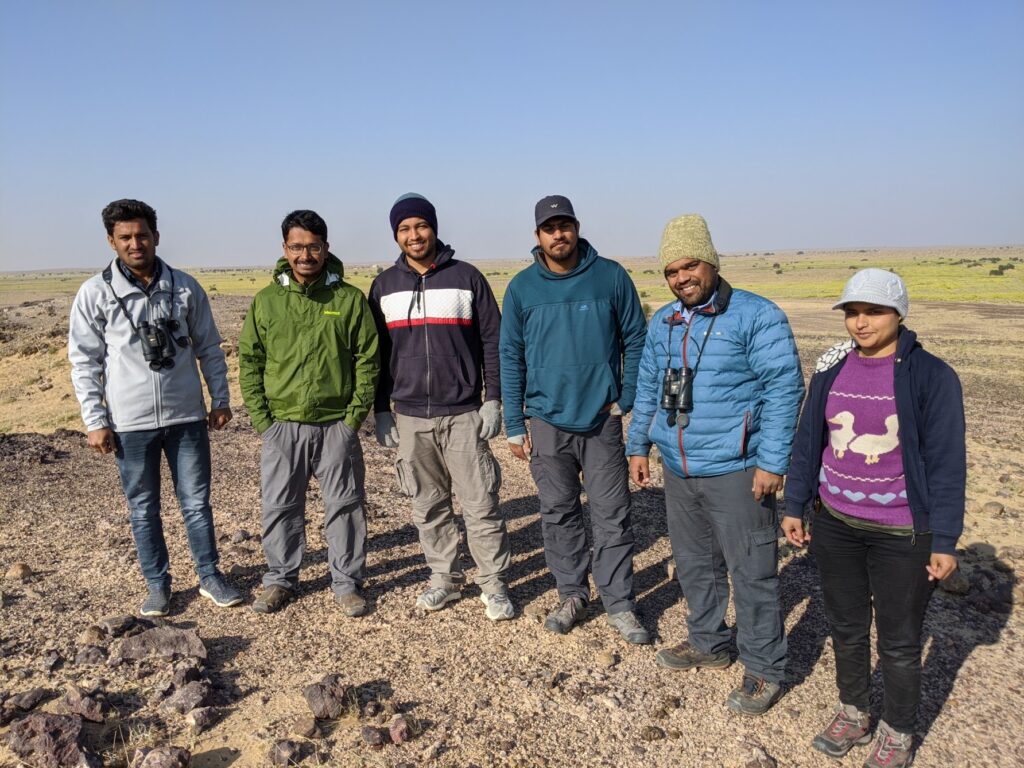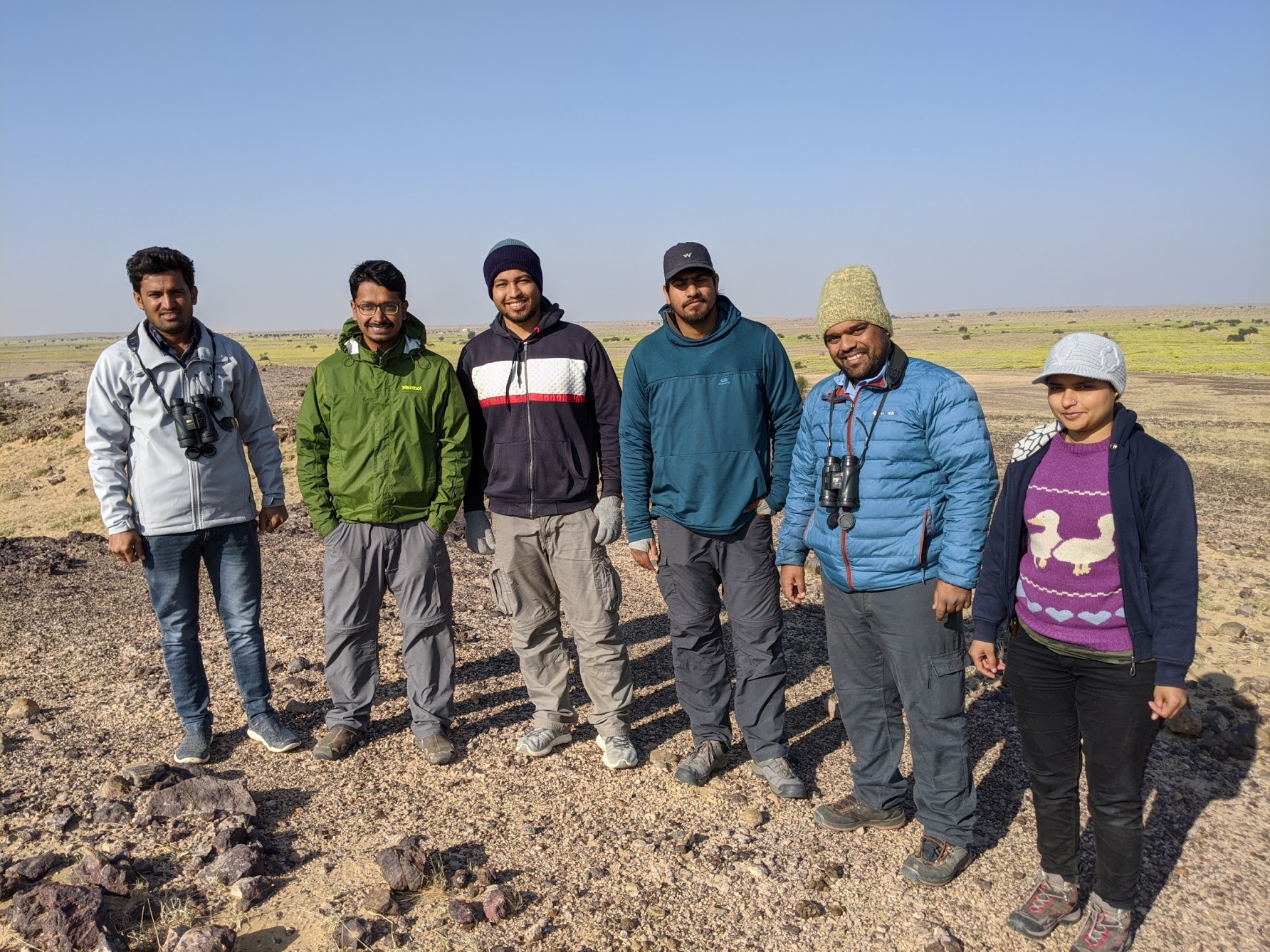Martin Goodman
The jeep is racing along the desert track when it pulls up. A motorcyclist has flagged us down. He has the sighting of a poacher to report.
Radhey Shyam Bishnoi, the young man who is our guide, pulls out his phone and relays the sighting to others. Radhey oversees an area of the Thar Desert of 100km by 80km. That’s vast for a lone volunteer in his early twenties. It’s made possible by his phone. Camel herders, shepherds, labourers in the area all have their own phones in which Radhey’s number is stored. If they see a poacher, Radhey is called. In turn he calls his colleagues and the poacher is hunted down.
Other reports come in too. Radhey clicks through his phone’s gallery and shows me a short film of a Great Indian Bustard (GIB) beating its vast wings. It has been trapped in the barbed wire of a fence. Radhey came along and freed it.
Seven species of vulture share this desert habitat. In the early mornings, they gather around the carcases of cattle left as food for them on the outskirts of a village. These carcases are safer than the cattle left on rail tracks after being hit by trains. When alerted to these, Radhey will pull the carcase off the tracks so vultures aren’t struck by trains while feasting. And when he finds vultures sickened by eating poisoned carcases, he injects them with atropine. In the last four years he’s saved fifty to sixty birds in this way.
In that same time span, he’s saved between five hundred and six hundred chinkara, the small gazelle that are endemic to this desert area of North West Rajasthan. These are victims of poachers and game hunters but also feral dogs. In saving these chinkara, Radhey is keeping close to the traditions of his Bishnoi community. Since the 15th century the Bishnoi religion has seen its followers strict in the belief that the lives of trees and animals in their community are as valuable as their own lives. Women suckle orphaned chinkara, communities run rescue centres, and men lose their lives in fighting off hunters. Would Radhey go so far?
I soon learn my answer. Most Bishnois live in the countryside near Jodhpur. Radhey’s community is a day’s drive west in the Dholia village, close to the town of Jaisalmer in Rajasthan state in India. That sees him inside the terrain of the GIB. Till a visit to the Indian Bird Fair six years ago he was busy protecting chinkara. That annual Fair in Jaipur wakes school students to the concept of bird conservation, and Radhey’s life swung around. The GIB is the State Bird of Rajasthan and faces extinction. Radhey has dedicated his life to its survival.
We drive beneath high-tension wires strung between pylons. This pathway for vehicles is a flyway for birds as they move between their feeding grounds and water supplies. With its eyes set on the sides of its head the GIB is adapted to a desert’s far horizons and can scan wide for dangers. It is also the world’s largest flying bird. Its flight is heavy, and so its flight is low, at about the height of the power lines. Its eyes leave it blind to the danger ahead. The world population of GIB is about 150. Between 10 and 15 birds are killed by collisions with wires each year. That is a fast race toward extinction.
One GIB was killed by these wires above us. Radhey found the bird and called in his friends. Report such a death and the authorities would send along some minor official to bury the body. Radhey demanded more. The friends protected the GIB’s dead body while Radhey climbed to the top of a pylon. Fix reflectors to the wires, Radhey demanded from on high, or he would jump to his death.
Officials came, heard him and believed him. The reflectors were promised and delivered. Fitted to the wires, they flash sunlight by day and store solar energy to emit LED signals at night. They bring a 50% reduction in bird deaths. That is one technological solution to the huge problem these high wires have brought to this region. We’ll revisit that, but first let’s complete this current journey.
Radhey is using his eyes. He pulls the car to a halt, swings open its door, and has me climb out and crouch low. There, over there, can’t I see them? I train my binoculars to where Radhey points, see nothing but desert, and then the birds come into my sight. In areas where they feel threatened, GIB tend to travel alone. Lately those watching the birds in this district have seen flocks of up to eleven. Here I am graced with the sight of five, all males, coursing between the khejri trees and bending long necks to pluck insects out of the grass-dusted earth.
A few years ago there were just two or three GIB in this area. Now there are thirty. A rise in the bird population here has mirrored a decline in the official Park’s conservation area on the far side of the city of Jaisalmer. Have conservation patrols of folk with phones made all the difference? I head out to the Park’s headquarters in the town of Sam, just inside the Desert National Park, to find out.

6 AM. When I arrive some of the team of scientists in the research station are still cocooned in sleeping bags. Tea rouses them, revives me, and four join me in a jeep. We head away from the National Park’s official boundary, for the GIB roam areas shared with humans. Veering off-road we startle a herd of nilgai, known as blue bulls, large antelopes that charge toward the sunrise in a cloud of kicked-up desert sand. We’re being guided in by PTT – a platform transmitter terminal fitted to one of the flock to send us its location. We climb a mugarra, a rocky outcrop about forty feet high, for its view.
I’m graced with my second viewing of the birds, three GIB this time, early February and the one male is already inflating his chest in display. They are exploring grassland beneath a wind turbine. That turbine’s powerlines stretched above them.
Dr Sutirtha Dutta first came to the Thar Desert from his native Calcutta, researching the spiny-tailed lizard for his Masters. He stayed on to complete a PhD on the GIB and now leads this research programme for the Wildlife Institute of India. “The GIB inhabits grassland and deserts, which are not considered ecologically or conservation-wise important,” he tells me. “They are viewed as unproductive land – the term used Is ‘wasteland.’ The dominant discourse is on how to change these lands to agricultural use more productive for human life. This philosophy has persisted till now. The current plan is to adapt the land for renewable energy. ”He looks out from our small peak, seeing wonders that others are blind to. “The landscape can seem monotonous to some people but it’s thrilling to have visibility up to the horizon. The GIB is iconic, a good rallying point for other species that are here.”
In 2016-17 Dr Dutta and a colleague performed a continuous survey of 100km of these power lines, collecting bird carcases before they could decompose. They retrieved five carcases per kilometre per month, so judged that 100,000 birds per year die in a 4,000 square km area. The 2017 report has yet to provoke any significant action; one common lament I hear in India is of ‘tragic, rigid bureaucracy’.
In Gujarat, power companies have buried new powerlines to protect flyways of flamingos. In this GIB territory, Sanctuary Nature Foundation has been pleading with power companies to mitigate 500km out of 6,000km of powerlines, in areas that most threaten extinction of the GIB–to little avail so far. There are legal directives for companies, but implementation is moving at a slow rate. Undergrounding the cables and installing diverters in the areas of keenest need would cost around £30m. It seems very little to save the largest flying bird on our planet.
The team of scientists have a new study: collecting bird carcases from beneath the blades of the wind turbines. I ask Dr Dutta about the boost in GIB numbers in the area patrolled by Radhey. His answer is somewhat competitive. “People weren’t looking a few years back,” he said, and felt that the adjacent military zone leaves an undisturbed area for the bustard. However, “The vigilance network is absolutely amazing and worth replicating.”
The scientists have devised a separate mission. An entomologist, for example, combs ground recently foraged by the GIB to map the spider species in this area. They need to know the birds’ preferred diet. Why? They are losing hope that the species will survive till land now regarded as wasteland is appreciated as unique and valuable habitat and therefore protected. Their recent success has been in hatching nine eggs taken from the wild. A captive bird population is being developed that might restore birds to the habitat when the fourth or fifth generations from this captive breeding colony are released. As Dr Dutta says, ‘The philosophy is to buy time.’
The scientists use camera traps to reveal the predators of the GIB’s eggs: foxes, mongoose and feral dogs. Back in the Dholia village, Radhey’s mentor Kamlesh Bishnoi works with ears and eyes. Employed by the forestry department, Kamlesh is in his forties, small, sturdy, dark complexioned, a woolly hat with ’76 on his head when we meet before dawn. We sit on the mattress-free cot bed in his room and he brings us tea there. His room is empty of possessions; Kamlesh uses his salary to pay rewards to their network of informants and buy them such gifts as a torch. The official position also allows him to carry a gun and be near the protected GIB eggs. GIB has a slow reproductive rate of just one egg a year. Each egg is laid on open ground. 40% of chicks make it to one year; in captivity, safe from overhead wires, they can live to 28 years. The birds themselves are elusive so the eggs are hard to find, but when Kamlesh does spot one he sets up a tent at a respectful distance and moves in. Through the 28 days of incubation Kamlesh is there watching. At night he reckons the bird is safe, and so between 9 and 4 heads home to sleep. The hatched chick will hide beneath the apron of its mother’s feathers, and Kamlesh will then let them be.
Young scientists, volunteer patrolmen, forest guards, camel herders with their smartphones–different degrees of technology are involved in battles for conservation, but at their heart is always an exquisite degree of human care and attention.
